Employee Advocacy in 2024: Everything A Leader Needs To Know!
In the fast-paced landscape of 2024, employee advocacy has evolved into a strategic imperative that defines the success of organizations. Gone are the days when it was merely a buzzword; today, it is a potent force that fuels brand visibility, employee engagement, and provides competitive edge. In this comprehensive guide, we will take an in-depth look at the dynamic world of advocacy, unveiling its critical facets, its transformative impact, and the cutting-edge strategies reshaping how businesses thrive.
Key Takeaways
- Understanding the concept of employee advocacy.
- How can a leader implement an advocacy strategy.
- Know the benefits of advocacy and leverage them.
- Know the Ways to Build an Effective Advocacy Program.
What is Employee Advocacy?

Employee advocacy is where employees actively promote and support their company's brand, products, or services. Companies use the collective voice of their employees as reliable sources of information rather than depending primarily on traditional advertising or external influencers.
Easy right?
But there are a lot of aspects that you need to be aware of. First, a leader must learn the most effective and efficient methods to practice advocacy.
Second of all, a leader must ensure that employee advocacy is used in the right manner. The main purpose of it is to increase the use of social media platforms to improve branding and market reach.
So, what does the program consist of? It mostly comprises -
-
Sharing relevant information about the company’s service or product.
-
Promoting content that helps the associated partners or the audience.
-
Showcasing the company culture with the help of appropriate social media posts.
-
Talking about the organization's achievements, which the employees can proudly showcase on social media.
So, how do you make this program work well in a company? We'll explore that in this article. But before we do that, let's start by understanding the different types of advocacy.
Types of Employee Advocacy
1. Social Media advocacy:

Employees who share company-related content on their social media profiles are the most popular type of employee advocacy. This includes sharing blog entries, news stories, product updates, and other content. A technology business employee, for example, might write a blog post about the newest industry developments on their LinkedIn profile.
2. Referrals and Recommendations:

Employees can help their employers by referring potential customers, clients, or job applicants. Based on their personal experiences, they can endorse the company's products or services. A software firm employee may refer a friend to try their company's new software product.
3. Company Swag:

Employees can showcase their company’s cool gifts on social media when joining the organization. This will give a good impression of the company culture and something that potential recruits might look forward to.
Read more: 14 Awesome Company Swag Ideas That Your Employees Will Love
4. Internal Advocacy:

Employee advocacy does not have to be restricted to outside efforts. Employees can advocate for their company by sharing information about its principles, initiatives, and accomplishments with coworkers. An employee, for example, might post a company-wide email on a successful project on their team's internal messaging network.
5. Participation in Events

Employees might speak at conferences, webinars, or industry events to represent their organization. Sharing their knowledge and experiences helps to boost the company's reputation and visibility. At a digital marketing conference, a marketing agency employee could speak about the most recent strategies that brought success to the organization.
Benefits of Employee Advocacy

A good employee advocacy program in the workplace has several benefits. And the best thing is that it works both ways. There are benefits for the company and the employees with the right practices. Here are a few of the benefits that we think one should know-
Benefits for the Company:
1. Increased Brand Awareness and Reach:
Employee advocacy spreads a company's message through its employees' social networks. This increases the brand exposure to new audiences and potential customers who would not have been reached through traditional marketing means.
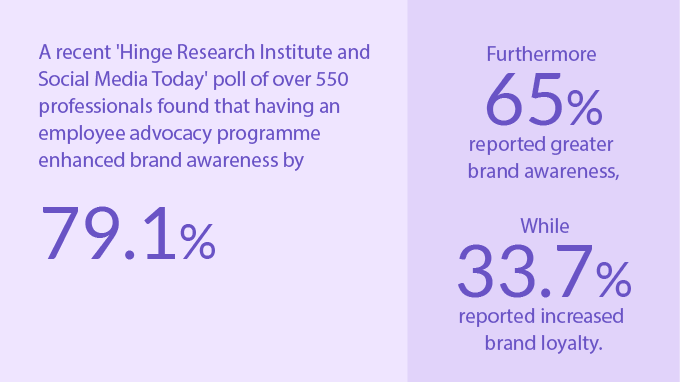
A recent 'Hinge Research Institute and Social Media Today' poll of over 550 professionals found that having an employee advocacy programme enhanced brand awareness by 79.1%. Furthermore, 65% reported greater brand awareness, while 33.7% reported increased brand loyalty.
2. Improved Recruitment:
Employees who actively advocate for their company, highlighting its positive features and culture, make it an appealing workplace for potential job prospects. As a result, there will be a wider pool of qualified candidates and a more efficient recruitment procedure.
Statistics to keep in mind:
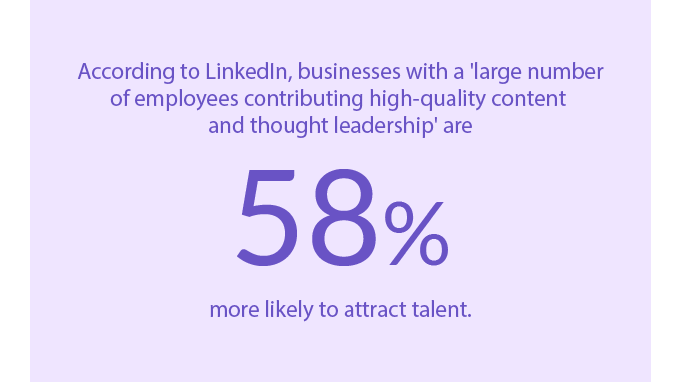
According to LinkedIn, businesses with a 'large number of employees contributing high-quality content and thought leadership' are 58% more likely to attract talent.
3. Higher Sales and Conversions:
Consumers tend to trust recommendations from individuals over advertisements. Employee advocacy can influence purchasing decisions and drive higher sales and conversion rates, as potential customers are more likely to engage with a brand recommended by someone they trust.
Things you should know:
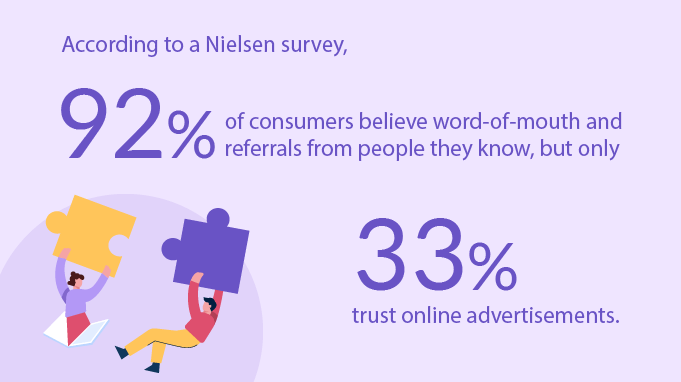
According to a Nielsen survey, 92% of consumers believe word-of-mouth and referrals from people they know, but only 33% trust online advertisements.
4. Greater Employee Engagement:
Employees who are engaged are more likely to advocate for their organization. Advocacy encourages a sense of connection and commitment, which increases total employee engagement and favors productivity and innovation.
Recommended Resource: 20 Practical Employee Engagement Strategies Every Leader Needs
5. Authentic Marketing:
Employee advocacy boosts the credibility of marketing efforts. One key factor is that because employees share their true experiences, the company's image becomes more authentic and relatable, resonating with customers and developing trust.
According to a 2018 study, brand messages published by employees have a 561% higher reach and eight times more engagement than those shared by the brands on their social media platforms.
6. Crisis Management Aid:
Having a network of employee advocates can help counterbalance negative perceptions during times of crisis or negative news. Employees can share positive tales and correct disinformation, assisting in managing the company's reputation during difficult times.
7. Cost Savings:
Employee advocacy is frequently less expensive than standard marketing methods. Leveraging employees' organic reach on social media can eliminate the need for costly advertising initiatives.
Benefits for Employees:
1. Enhanced Personal Brand:

Employees improve their brand by campaigning for their firm. Sharing industry insights, thought leadership, and company-related information can help individuals establish themselves as experts in their sector, boosting their professional reputation.
2. Expanded Professional Network:

Employee advocacy connects employees to a larger network of professionals within and outside the company. This extended network can lead to cooperation, collaboration, and career advancement opportunities.
3. New Skills Development:

Employee advocacy frequently necessitates the development of skills in content creation, social media administration, and communication. These abilities can be beneficial for both personal and professional development.
4. Rewards and Recognition:

Employee advocacy is typically rewarded and recognized by companies that respect it. Incentives, bonuses, or public recognition can all be used to inspire employees to advocate for the company actively.
(Source: Vantage Rewards)
5. Leadership Opportunities:

Advocacy can lead to opportunities for leadership both within and outside the company. Employees who constantly offer insights and participate in industry debates are more likely to be recognized as thought leaders, which opens doors to speaking opportunities, panel discussions, and other opportunities.
6. Job Satisfaction:

Employees are more satisfied with their jobs when they believe their voices are heard, and their opinions are valued. Employees can use advocacy programs to contribute to their company's success significantly.
Read more: An All-In-One Guide To Boost Employee Job Satisfactiont
7. Advancement Prospects:

Employees who actively participate in advocacy frequently stand out as proactive, motivated individuals who go above and beyond their job responsibilities. As committed and enthusiastic team members, they may be considered for progression within the organization.
How to Build an Effective Employee Advocacy Program

Like the pillars of great architecture, a good advocacy program will need a strong foundation. An employee advocacy program is a systematic project that encourages employees to promote the company's brand on their social media platforms. The goal is to boost their visibility and favorable image by leveraging their credibility.
Below are some concrete ways to help you build the program.
1. Get Leadership Buy-In:

Leadership buy-in is foundational to any internal initiative. Leaders actively supporting and participating in employee advocacy send a strong message about its importance.
Furthermore, the visible involvement of senior leadership can directly impact wider participation and commitment across the organization. Their support can help to distribute resources, emphasize priorities, and motivate participation from all levels of the organization.
2. Set Goals and KPIs

Every effective program starts with clear and concise objectives. In the context of employee advocacy, goals range from enhancing brand visibility to driving web traffic or fostering community engagement.
The Key Performance Indicators (KPIs) help assess your ability to meet these goals. By setting measurable KPIs, you not only give direction to the program but also have tangible metrics to evaluate its success and areas for improvement.
3. Identify Advocates

While it’s essential to include everyone, certain employees will naturally be more inclined towards advocacy due to their enthusiasm or social media presence. You must have a good eye to pick them out and ensure they get involved with the program.
Recognizing and leveraging these naturally passionate advocates early in the process can set a precedent and provide a template for others to follow. These individuals can also offer valuable feedback and help refine the program.
4. Create Guidelines
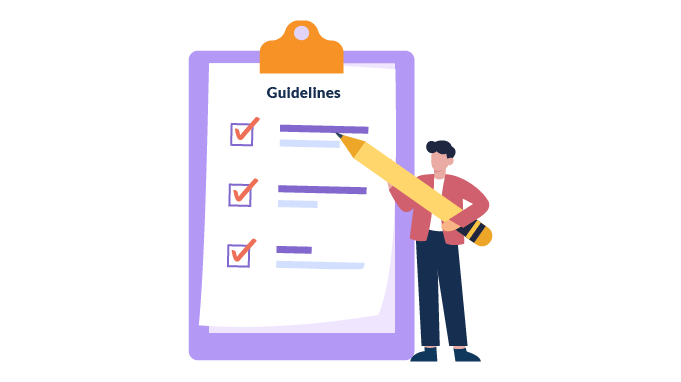
While you want employees to be genuine, providing them with a framework to ensure consistency and protect the company’s reputation is essential.
Guidelines can clarify which information is proprietary, how to respond to negative comments, and how to maintain professionalism online. This safeguards the company and supports employees in advocacy efforts.
5. Provide Training

Not every employee will be familiar with best practices for social media or understand the nuances of online engagement. Providing them with training can equip them with the necessary skills while ensuring that they represent the company effectively. This can range from workshops on crafting engaging content to webinars on digital etiquette.
6. Develop Content Strategy
For employees to advocate, they need content that's worth sharing. The content should resonate with your company's values and be relevant to the target audience, whether it's informative blog posts, engaging videos, or insightful infographics.
An effective strategy doesn’t just focus on quantity but emphasizes the quality and relevance of the content. Remembering that the content covers the necessary DEI topics while not focusing more on sensitive topics is also essential.
7. Encourage Sharing
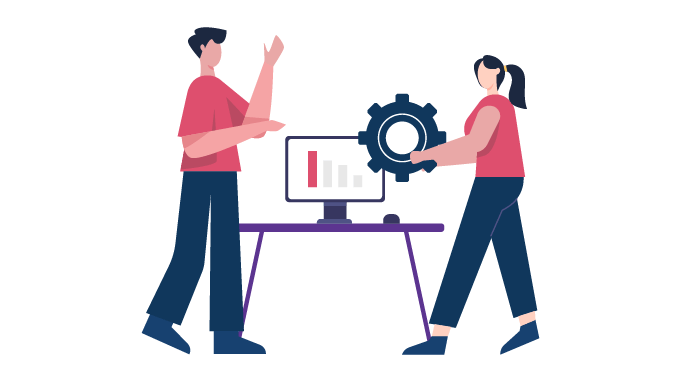
As a leader, you must cultivate an environment where sharing becomes second nature. This involves regular content updates, reminders, and tools that make sharing straightforward and intuitive.
Additionally, highlighting success stories or top sharers can serve as motivation and provide best practice examples for others.
8. Offer Incentives

Positive reinforcement can drive engagement, especially when it comes down to advocacy. By offering rewards or recognition for active participation, you appreciate employees' efforts and instill a sense of purpose and motivation. Incentives can vary from public recognition in company newsletters to tangible rewards like bonuses or redeemable points.
Read more: What No One Tells You About Employee Incentive Programs
9. Launch Program

The start of your advocacy program should be impactful. You generate excitement and enthusiasm by organizing a launch event, whether physical or virtual. This is the time to explain the program's objective, highlight its benefits, and provide resources for individuals interested in participating.
10. Integrate with HR

Human Resources has a significant impact on business culture and employee engagement. You may ensure the longevity and integration of your advocacy program by linking it with HR activities.
This could take several forms, such as embedding advocacy into employee onboarding or including it in the yearly review process.
11. Leverage Analytics

Data offers insights. Using analytics, you can understand which content is resonating, identify the most active advocates, and spot trends or areas for improvement. Reviewing this data ensures your program remains dynamic and adapts to changing needs and circumstances.
12. Listen and Optimize
An effective program evolves with the changing dynamics. You ensure that the program remains relevant and effective by fostering open communication channels where employees can offer feedback, share their successes, or voice concerns.
Regularly taking feedback and refining the strategy ensures the advocacy program is sustained and optimized.
How to Improve your Employee Advocacy Strategy

Employee advocacy is not just a “set and forget” initiative. It requires constant monitoring and timely adjustments to make it more effective. Here are a few pointers on improving your advocacy strategy with time.
What does stats say?
Gartner predicts that by 2023, "90% of B2B social media marketing strategies will include scaled employee advocacy programmes."
1. Gather feedback
Direct inputs from employees involved with the advocacy program can help you gather crucial insights. The feedback ensures that the program aligns with employee experiences and preferences, making it more dynamic and effective. The idea is to sustain the program and improve participation in the long run.
Employee advocacy benefits extend beyond the firm and have a favourable impact on the advocates themselves. Almost 86% of advocates in a formal program reported that their activity in social media benefited their job.
2. Provide training
The digital landscape and business objectives change with time. And everyone involved in the organization must keep up with the pace. Hence, regular training ensures that employees are up-to-date with their skills and knowledge, enhancing their advocacy impact.
3. Recognize top advocates:
The idea of advocacy thrives on motivation, and you must keep recognizing the top employees. You can reward their efforts through monetary awards or by appreciating them for their efforts. It serves as an inspiration to others and creates enthusiasm in employees to do better.
(Source: Vantage Rewards)
4. Align With Company Initiatives
Employee advocacy efforts should always align with the company's initiatives. The message becomes disjointed if it does not mirror company values and goals. Hence, it is important to synchronize with broader company objectives, which ensures a unified, powerful brand voice.
5. Offer Content Suggestions
Advocacy should not be a guessing game. It must be straightforward and to the point to clarify the message. Therefore, it is necessary to share relevant content that resonates with the audience. It helps maximize the shared messages' reach, engagement, and impact.
6. Make Sharing Effortless
Sharing the brand message through the advocacy program should be easier. It will help the employees indulge in the program without much effort. Streamlined tools and processes reduce barriers, making it simpler for employees to advocate, increasing overall participation.
How to Measure Employee Advocacy Plan

Measuring your employee advocacy program will give you a fair idea of its direction. It is necessary to measure the program to check the success of the program. Below are a few pointers that will help you measure the program correctly.
1. Employee Participation Rates
Determining how many of your employees are actively involved in the advocacy program is critical. A high level of involvement implies an engaged workforce, while a drop may signal the need for program improvements or further engagement activities.
2. Content Shares
Monitoring the volume of content shares reveals how frequently employees advocate for your brand. A high sharing rate indicates an effective content strategy, whereas a low rate may suggest concerns with content relevance.
3. Social Reach
This metric calculates the total audience size of all employee networks. A broad reach signifies broad visibility, demonstrating your employees' collective power in amplifying the brand's message.
4. Engagement Rates
Beyond sharing, understanding the resonance of shared information with consumers is critical. Likes, comments, and shares are all included in this metric. High levels of engagement imply that the information is relevant and that the employees are honest with the audience.
5. Website Traffic
An increase in website views is one immediate benefit of advocacy. You can evaluate how much of your digital traffic is driven by employee advocacy initiatives by analyzing referrals from social platforms.
6. Lead/Sales Conversions
Advocacy is about more than simply visibility; it is also about results. Track the number of leads or sales generated directly from advocacy-driven traffic to provide a measurable ROI for the program.
Higher leads indicate that the program is in the right direction, and lower leads will indicate that it will need more assessment and fine-tuning.
7. Employee Satisfaction
Advocacy should be enjoyable. You may assess employee satisfaction with the program by surveying them, ensuring it remains a positive and fulfilling experience supporting continuous involvement.
Read more: 9 Best Practices to Keep Employee Satisfaction High
8. Program Costs
It is critical to strike a balance between spending and results. By comparing program costs, such as training or incentives, to program returns, you can guarantee that the program remains cost-effective and adds true value to the organization.
How to Choose the Right Employee Advocacy Platform

It is essential to remember that choosing the right employee advocacy platform will bring in the desired results and success. It should be tailored to the organization’s needs and requirements while making it easy to use. Here are a few things to consider while onboarding the right platform.
1. Ease of Use:
It should be easy to use and provide the functionality of one-click sharing. This makes content sharing hassle-free and less complicated while improving the participation rate in the program.
2. Integration:
The employee advocacy platform you choose should allow you to integrate with the social media platforms. Such integrations make the workflow easy and manage the advocacy program in a structured way.
3. Analytics and Data Insights
Your advocacy platform must give you real-time data and analytics on how the program is running. You can make informed decisions and improve the program in the long run with transparent information.
The data will also help you significantly fine-tune the program and work on the areas that need improvement.
4. Multiple Platform Availability
Your chosen platform should have multiple platform accessibility to help employees run things on the go. And since everything is mobile nowadays, the platform must have mobile applications with varied functionalities, just like its web version. Ensure that you look into this as a priority and help the employees share more.
Examples of Companies with Best Employee Advocacy Programs
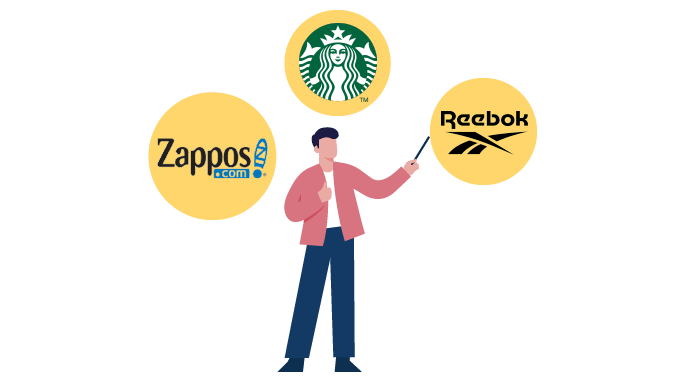
The program did not popularize itself, or did it? Well, not really. Companies worldwide have successfully used the program to its full potential. And we commend them for that.
Here is a list of some companies that made it famous.
1. Starbucks

Hello there, Coffee addicts. You probably know Starbucks is a coffee giant serving millions of people with fantastic coffee. Who am I kidding? Everybody knows that.
Apart from serving the best coffee, they also excel at one thing: employee advocacy.
They have a dedicated program for it and have named it “Starbucks Partners.” Any employee that promotes their company socially earns the name “Partner.”
It is their official way to welcome employees to the program.
Starbucks does not keep its employees hanging around when they join the program. Instead, they have specific guidelines and clear instructions regarding what they should do.
Howard Schultz, the CEO of Starbucks, believes that the employees are the true ambassadors of their brand and primary catalysts for delighting customers. This thought process made the program a great success and provided learning opportunities for their employees in the long term.
2. Zappos
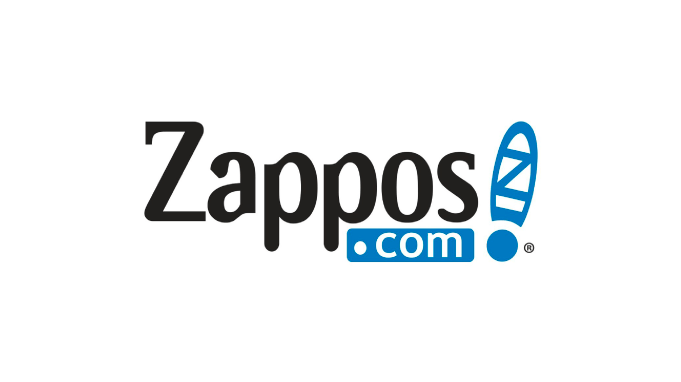
Zappos has done a spectacular job since its inception in 1999. They included employee advocacy in their business plan right off the bat. Their main aim was to provide exceptional customer service while creating an employee-centric work culture was the key to that.
They successfully nurtured a culture where employees felt at home and happy. This led to the social sharing of the culture that put employees first before anything. In return, it successfully led the employee advocacy program towards success.
3. Electronic Arts: It’s in the Game

Almost everyone is a FIFA buff, and it’s popular worldwide. The main developer behind this game is EA, as it is known. The company has kept fans excited and excited about the game every year.
Developing a successful game is their forte. But they were building and performing well on another front: employee advocacy.
Despite a vast and dispersed workforce globally, they created a good advocacy program.
How did they do it?
In 2014, they launched the EA Insiders program with the help of an advocacy tool. The main objective of the program was to.
-
Connect the employees through the program.
-
Connecting the whole community of players with the employees
With these two goals in mind, they created an internal culture of social sharing. As a result, the employees felt more connected with the organization. This led to relevant content sharing, highlighting upcoming events/projects and initiatives that excited everyone.
Over 1000+ employees joined and made the program achieve a collective audience of 1.1 million people. It increased further engagement, and employees were more invested in the program.
The best part? They also reward their employees based on the highest engagement and likes. Thus, it inspired everyone to try and invest their time in the program.
4. Reebok

The sports apparel company Reebok has successfully facilitated employee advocacy in their organization.
Reebok encourages its employees to share photos of themselves wearing the company products and share them on social media. They even have their custom hashtag, #FitAssCompany.
The employees took up the challenge, leading them to emphasize their fitness and health more.
Reebok onboarded employees who had good social media awareness. Afterward, they are asked to target specific posts like cycling, running, and weightlifting.
Moreover, they use two systems to create their content. Number one, they create blogs and articles, which are then shared with the employees through an advocacy tool. And the second one requires the employees to submit their content. The content is shared with the company's employees in their channels upon approval.
Employee Advocacy Tools that You can Use

You might now clearly understand what revolves around employee advocacy and how you can kick-start the program from scratch. However, even after proper planning and execution, you will need a platform that makes your job easier.
Worry not if you are still wondering which platforms you need to look out for. You need to consider some of the existing employee advocacy tools in the market.
The list was compiled based on the average ratings gathered from G2 and Capterra.
1. Hootsuite

One of the top-notch platforms that allow you to schedule and post content to the right channels, which can be tracked effectively, is Hootsuite. With Hootsuite, you can also strengthen relationships with your customers by connecting with them in real time.
Another thing to remember is that the platform allows you and your employees to strengthen their skills with the Hootsuite Academy feature.
To know more, click here!
2. Sprout Social

Sprout Social is a user-friendly platform that enables smarter, faster business impact through social media. With the social insights that matter most—at scale—empower your teams to better interact with audiences, streamline publishing workflows, communicate in real-time, and power key business choices.
To know more, click here!
3. DSMN8

DSMN8 is a platform for employee advocacy that enables you to encourage your staff to become influencers.
Employee advocacy has an impact on many aspects of your organisation, from marketing and sales to human resources and recruitment. So, whether you want to boost your reach and engagement, increase your inbound sales, or discover your next superstar employee, DSMN8 provides a solution.
They make it simple for businesses to use their employees' impact, assisting their staff in becoming brand champions and more effective social sellers. Their creative solutions make it simple for your employees to find, produce, and share company-approved content.
To know more, click here!
4. Sociabble

Sociabble is another excellent tool that provides employee advocacy where employees can drive social media influence to increase reach, traffic, and conversion rates. And it does not limit itself there only.
It has some extra features like the internal communication tool to drive effective communication through a centralized hub that is easy to use.
Another feature to remember is the social selling feature that allows employees to boost lead generation through social media influence. Sales teams can demonstrate their expertise in engaging, generating, and tracking leads with the help of social selling.
Further, it boosts employee engagement and empowers employees.
To know more, click here!
Conclusion!
The program will need a tremendous amount of patience and effort to grow. The initiative's growth will flourish with everyone's participation, which can exponentially improve the organization's bottom line along with a far greater social media presence.
One should not expect results right after implementing it. We all know that "Rome was not built in a day," so give the program time to run and stick with it. You will see the positive results and feedback it generates for the company in the long run.
FAQ
Q. What are some examples of employee advocacy?
A. Examples include employees sharing positive company content on social media, referring potential clients, or promoting company values in community events and forums.
Q. What is an employee advocacy plan?
A. An employee advocacy plan outlines strategies and guidelines for employees to promote and represent the company, often leveraging tools, training, and incentives.
Q. How can companies ensure consistency in employee advocacy?
A. Provide clear brand guidelines, regular training sessions, and utilize advocacy platforms that allow content pre-approval.
Q. How can feedback be incorporated into an employee advocacy program?
A. Solicit regular input from staff through questionnaires or meetings, and alter the program to accommodate their issues and suggestions.


















